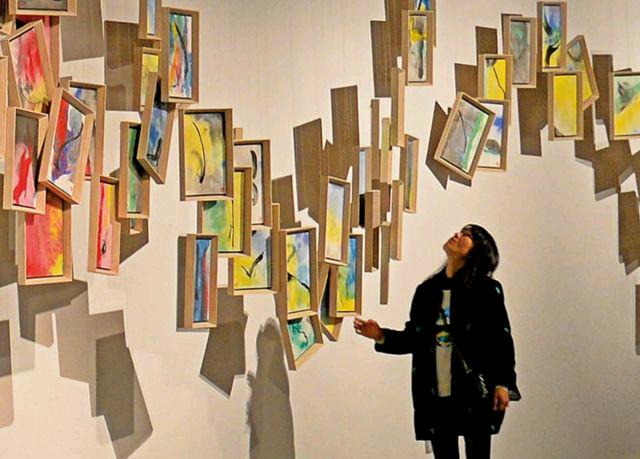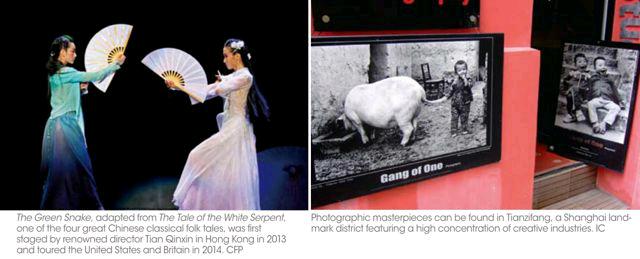Fresh Air for Chinese Art and Literature
by+Gong+Haiying
On October 15, 2014, Chinese President Xi Jinping presided over a forum on literature and art featuring 72 accomplished representatives from literature, drama, music, dance, fine arts, calligraphy, photography, quyi (Chinese folk art), acrobatics, and movies and television.
Since the introduction of reform and opening up in 1978, no top state leaders had ever held such a symposium to discuss literature and art. During the forum, President Xi delivered a two-hour speech that sparked a buzz across the country.
Where to Go?
President Xi declared that literature and art are crucial for both the Party and the people and stressed the importance of their progress. As the bugle calls of the era, they best reflect the style and features of the times and guide social ethos. He added that literature and art play an irreplaceable role in achieving the Two Centenary Goals and realizing the Chinese Dream of the rejuvenation of the Chinese nation, urging those engaged in literature and art to make a difference.
During the forum, the President discussed what the Communist Party of China (CPC) should do to guide literature and art in an era of striving for the Chinese Dream of the rejuvenation of the Chinese nation while fostering and promoting core socialist values.
According to him, the primary task is navigating artistic and literary work in the correct direction.
As President Xi asserts, the fundamental function of socialist literature and art is reflecting the heartfelt wishes of the people, and to this end, professionals should adhere to the principle of serving the people as well as socialist modernization.
At the Yanan Forum on Literature and Art 72 years ago, Mao Zedong clearly defined the core of literature and art to be found in understanding “what to do for the masses” and “how.” Xi Jinping actually reiterated Maos ideas, which are still considered pertinent today.
Then, the President gave instructions on how to create literary and artistic works that feed the demands of the new era.
Xi pointed out that “the people are the inspiration for artistic and literary creation. Without them, literature and art are rootless duckweed – a lot of fuss about an imaginary illness or a zombie without soul. The determination of outstanding work is made by the people based on the expression of their most intimate emotions and treatment of their hearts.”
At the Yanan Forum 72 years ago, Mao Zedong passionately described the peoples lives as “mineral reserves for artistic and literary creation,” which remains identical in Xis mind.
Current Challenges
The issues and obstacles China has been facing in comprehensively deepening reform since the 18th CPC National Congress are the basis for Xi Jinpings insight on the countrys literature and art. Both questions he raised concerning literature and art and answers he suggested actually responded to practical problems that persist.
Xi addressed real issues affecting Chinese literary and artistic circles today. In terms of artistic creation, the quantity is inspiring but the quality disappointing. Plagiarism and imitation abound, leading to a cookie-cutter approach in production and consumption. According to the President, art works should not be a “slave”to the market and should not bear “the stench of money.”
“Artists should put the social benefits of their work before everything else, and good art is intellectually and artistically successful as well as popular among the public,” he said. “Popularity should not necessitate vulgarity and hope should not entail covetousness. Pure sensual entertainment does not equate to spiritual elation.”
Li Xuejian, chairman of the Chinese Association of Film Artists, opined, “Some actors and actresses become arrogant when they get famous. The social environment fosters their arrogance. For instance, no matter what he or she does – bad or good – a movie star is still adored by his or her fans.”
Xi Jinping warned literary and art circles to remember that creation is their essential task and serves as their foundation. He urged artists to “settle down and refine their creation.” They should let their imaginations run wild but stay practical to produce the optimal spiritual and intellectual nourishment for the people. Regardless millions of methods of artistic creation, the “most fundamental, vital, and steady path requires roots in the people as well as life.”
Fresh Air
Celebrities across the country raved about the forum injecting fresh air into Chinas literary and art circles. Gao Hongbo, a famous childrens writer, asserted, “Finding roots in life will be the trend for Chinese artists in 2015.” Such a trend is nothing new. Art emerged from life at grassroots levels and art troupes have been touring local communities for ages.
Many state-level institutions and organizations, including the Chinese Writers Association, Ministry of Culture, and China Central Television (CCTV), have launched campaigns themed “Im- mersed in the thick of life and rooted in the people,” encouraging writers, artists and movie and television producers to seek inspiration from and perform and produce for the grassroots level.
“Sensory entertainment doesnt bring real joy,” noted Tian Qinxin, a well-known Chinese stage director. “The new year will bring a rollback of the tendency of excess entertainment plaguing art and literary circles.” On January 14, 2015, The Taking of Tiger Mountain, a movie based on a Chinese revolutionary classic, broke box office records by earning 800 million yuan in 20 days and became Chinas best-performing New Years release ever. It also hinted at changing demands of Chinese spectators: Serious literary work is gaining greater acclaim than pure sensory entertainment.
Media reports have documented how, over the past few years, Chinas administrative departments such as the Ministry of Culture and State Administration of Press, Publication, Radio, Film and Television have strengthened their administration of literary and art circles through measures to discourage art troupes from performing overseas for 15 minutes of fame and those who behave notoriously.
Moreover, China is busy preparing for the launch of its first cinema chain devoted to art-house and independent films, which is expected to open in Beijing in 2015. The chain will widely expand channels to disseminate fine-quality artistic films and effectively avert the invasion of excessive entertainment.
This breath of fresh air will become “new normal” for literature and art in China.
China Pictorial2015年2期
